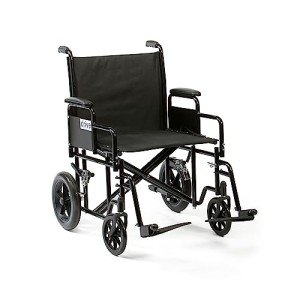Bariatric Wheelchair Seat Width
Seat Width
Having the appropriate seat width is important to wheelchair users who invest longer durations in their chairs. Too narrow a seat will cause pressure on the hips and thighs which could cause sores or pressure points. Having too wide a seat can also make it challenging for the user to reach the hand rims to move themselves or maneuver in small spaces.
To measure the correct seat width an individual would rest on a chair normally and have their measurement taken across their lap at the largest point which is typically their hips. A wheelchair measuring tape can be used to measure this, however a lawn stick is chosen as it prevents people from covering the tape around their hips which would offer an inaccurate result.
The basic wheelchair seat width is 16" (narrow adult), 18" (basic grownup), and 20" (large grownup). For bariatric patients, a 24" seat is readily available. This durable extra broad bariatric wheelchair from Medline features swing-away footrests, a carbon steel frame with rust- and chip-resistant chrome plating, and easy-to-clean vinyl upholstery. It has a weight capacity of 500 pounds.
Seat Depth
Generally, the seat depth of a bariatric wheelchair was included 2" to the measurement taken at the user's largest point (usually their hips). This was indicated to accommodate extra layers of clothing that might be worn during winter. Nevertheless, this practice is ending up being less common as wheelchair users have the ability to invest more time indoors and are not wearing long coats. This makes the seat depth of a chair lesser when picking a bariatric wheelchair. However, it is still important to select a choice that offers adequate assistance for bigger users.
The Medline folding extra broad bariatric manual wheelchair includes a comfortable 24" seat width and a durable slide tube silver vein frame. It also has an adjustable axle and tool-free elevating legrests.
Seat Height
When it concerns identifying the correct wheelchair seat width you ought to constantly measure from the user's largest point which is generally their hips. You will likewise need to think about whether the user is going to be using a winter season coat as this may add 2" to the width required.

When a wheelchair remains in usage it ought to just be operated on level surfaces with the wheel locks fully engaged. This is to prevent the chair from having the ability to move inclines that are 10 degrees or greater. It is likewise essential to keep in mind that any activity that might shift the center of mass in the chair ought to be finished with care. bariatric transport wheelchair 400 lb capacity consists of grabbing items that need the person to lean out of their seat or trying to stand up from it.
Whenever you have the chair in use it is suggested that you routinely check it for damage and lube any areas that are deemed essential. For example, the casters must be lubricated by eliminating the caster fork and utilizing a multi-purpose grease to apply to the caster stem bearings. Also, the foot plates can be changed by loosening up the bolt and after that moving them to the preferred position. This enables the feet to sit easily on the footplate and prevents any pressure points from forming. This can be very unpleasant for the user and if left unattended, can cause pressure sores.
Weight Capacity
Bariatric wheelchairs are created to support more weight than basic wheelchairs. This makes them sturdier and much better geared up to handle falls. They are likewise usually larger and broader, making them less maneuverable in tight spaces than standard wheelchairs. They require cars with unique ramps and lifts to pack them, along with drivers who know how to best transport them from one area to the next.
When selecting a wheelchair, consider its weight capacity as it will be the main determining consider whether it will accommodate your guest's needs. The weight capacity of the chair is frequently listed as a static load, meaning that it indicates the quantity of weight the chair can easily hold while standing still. Nevertheless, some producers likewise list an active load that is based upon a drop test and can mimic the impact of someone taking a seat in the chair. This may be a more reputable measurement of the weight limit, depending on your needs.
If you prepare to perform activities that move your center of mass in the seat (such as reaching for objects), be sure to have front casters pointed in a forward direction and wheel locks engaged so the chair will not tip over. Likewise, inspect that casters are lubed regularly to prevent extreme wear and abrasions. The lubrication procedure includes removing the fork, separating the caster from the wheel, and greasing the caster stem bearings with premium multi-purpose grease.
